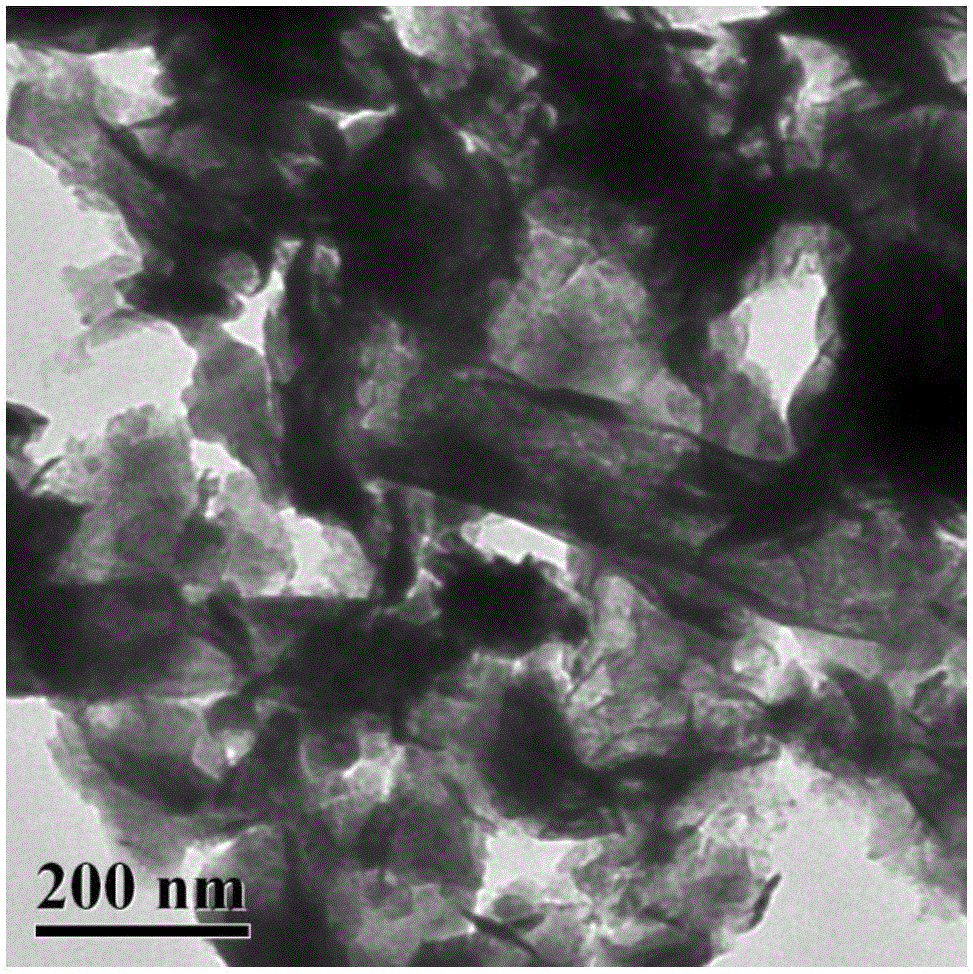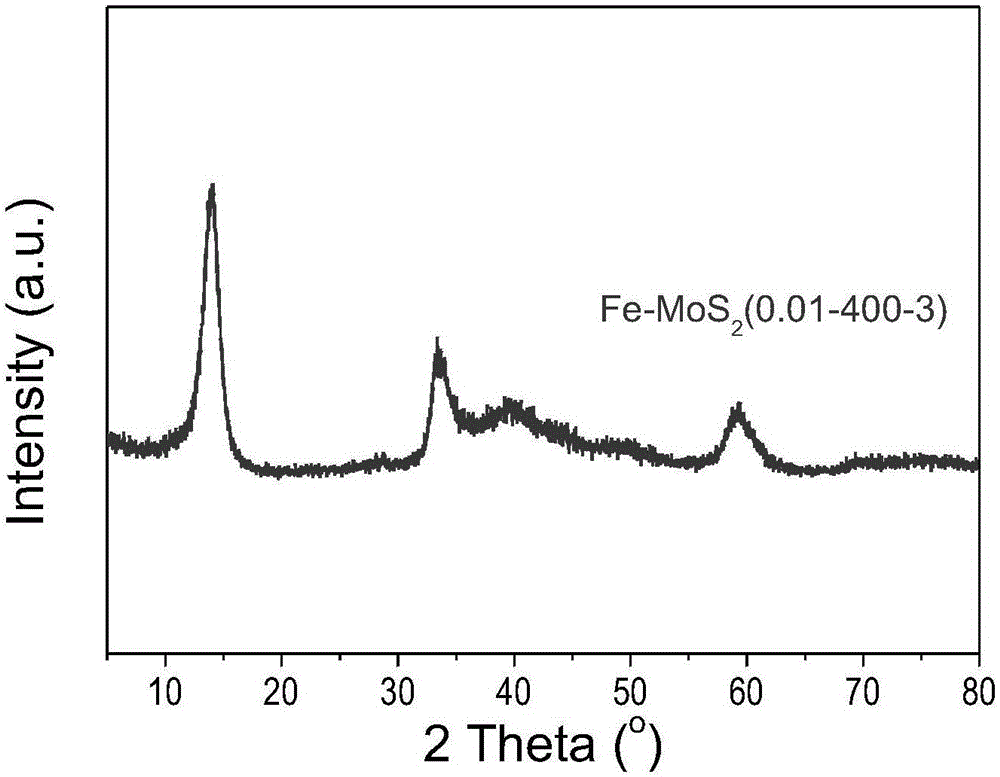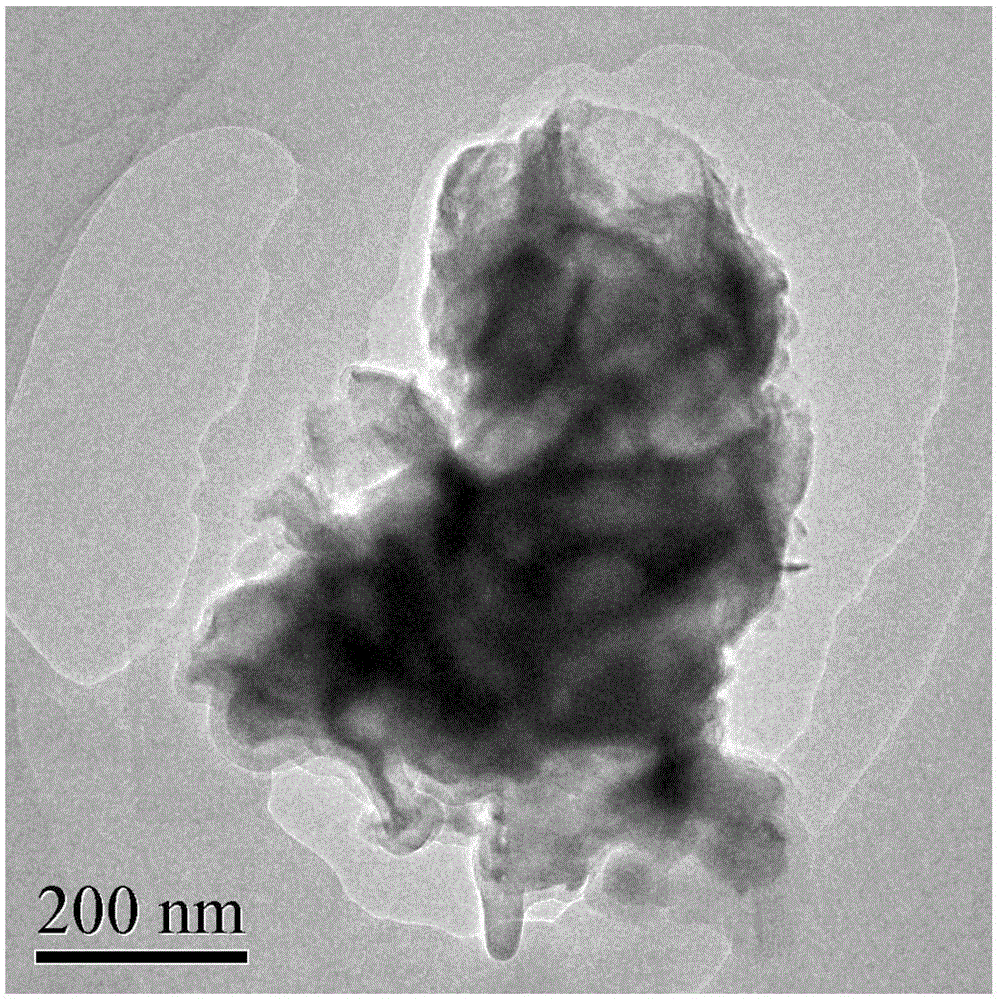Metal cation doped molybdenum disulfide material, preparation method and applications thereof
A metal cation, molybdenum disulfide technology, applied in molybdenum sulfide, chemical instruments and methods, chemical/physical processes, etc., can solve problems such as changing the structure of molybdenum disulfide materials
- Summary
- Abstract
- Description
- Claims
- Application Information
AI Technical Summary
Problems solved by technology
Method used
Image
Examples
Embodiment 1
[0024] Use MoO 3 (10mmol) was added as the precursor of molybdenum, ammonium sulfide (40mmol) was added, the volume of the mixture was adjusted to 200mL and pH=11 with deionized water and ammonia water, and the reaction was stirred at 70°C for 2h. Add 0.1mmol Fe 2+ EDTA complex, stirred and reacted for 1.0h, stirred and evaporated the solvent at 70°C, dried in vacuum at 100°C, put the obtained sample in the Ar gas flow after grinding, and roasted at 400°C for 3h to obtain the sample, coded as Fe -MoS 2 (0.01-400-3), and the XRD pattern shows that the interlayer spacing is 6.90 angstroms. Micromeritics ASAP 2010 physical adsorption instrument was used to measure the specific surface area of the sample. Before the test, the sample was vacuum treated at 110 ° C for more than 3 hours to make the vacuum degree reach 10 -6 About torr, and then tested at the temperature of liquid nitrogen (-196°C), the specific surface area is calculated using the BET equation. Nitrogen adsorpt...
Embodiment 2
[0026] Use MoO 3 (10mmol) was added as the precursor of molybdenum, ammonium sulfide (40mmol) was added, the volume of the mixture was adjusted to 200mL and pH=11 with deionized water and ammonia water, and the reaction was stirred at 70°C for 2h. Add 0.1mmol Mn EDTA complex, stir for 1.0h, stir and evaporate the solvent at 70°C, vacuum dry at 100°C, put the obtained sample in the Ar gas flow after grinding, and roast at 450°C for 3h to obtain the sample , numbered as Mn-MoS 2 (0.01-450-3), and the XRD pattern shows that the interlayer spacing is 6.50 angstroms. Micromeritics ASAP 2010 physical adsorption instrument was used to measure the specific surface area of the sample. Before the test, the sample was vacuum treated at 110 ° C for more than 3 hours to make the vacuum degree reach 10 -6 About torr, and then tested at the temperature of liquid nitrogen (-196°C), the specific surface area is calculated using the BET equation. Nitrogen adsorption and desorption experime...
Embodiment 3
[0028] Use MoO 3 (10mmol) was added as the precursor of molybdenum, ammonium sulfide (40mmol) was added, the volume of the mixture was adjusted to 200mL and pH=11 with deionized water and ammonia water, and the reaction was stirred at 70°C for 2h. Add 0.2mmol Co 2+ EDTA complex, stirred and reacted for 1.0h, stirred and evaporated the solvent at 70°C, dried in vacuum at 100°C, put the obtained sample in the Ar gas flow after grinding, and roasted at 420°C for 4h to obtain the sample, coded as Co -MoS 2 (0.02-430-4), and the XRD pattern shows that the interlayer spacing is 6.75 angstroms. Micromeritics ASAP 2010 physical adsorption instrument was used to measure the specific surface area of the sample. Before the test, the sample was vacuum treated at 110 ° C for more than 3 hours to make the vacuum degree reach 10 -6 About torr, and then tested at the temperature of liquid nitrogen (-196°C), the specific surface area is calculated using the BET equation. Nitrogen adsorpt...
PUM
| Property | Measurement | Unit |
|---|---|---|
| specific surface area | aaaaa | aaaaa |
| specific surface area | aaaaa | aaaaa |
| specific surface area | aaaaa | aaaaa |
Abstract
Description
Claims
Application Information
 Login to View More
Login to View More - R&D
- Intellectual Property
- Life Sciences
- Materials
- Tech Scout
- Unparalleled Data Quality
- Higher Quality Content
- 60% Fewer Hallucinations
Browse by: Latest US Patents, China's latest patents, Technical Efficacy Thesaurus, Application Domain, Technology Topic, Popular Technical Reports.
© 2025 PatSnap. All rights reserved.Legal|Privacy policy|Modern Slavery Act Transparency Statement|Sitemap|About US| Contact US: help@patsnap.com



